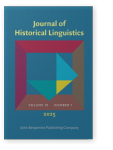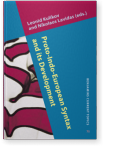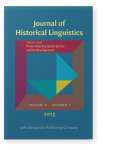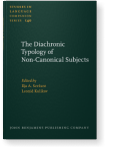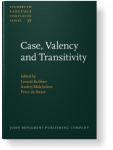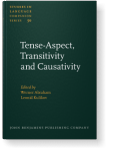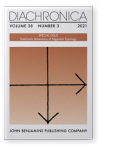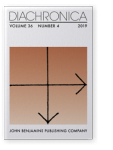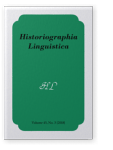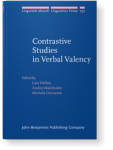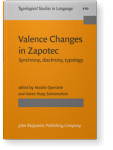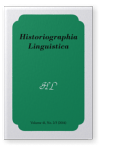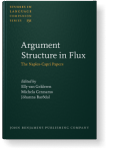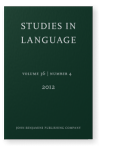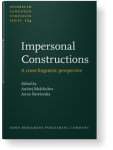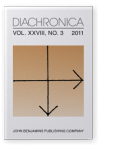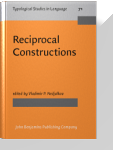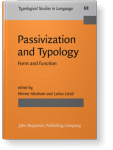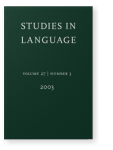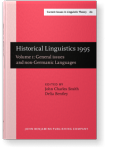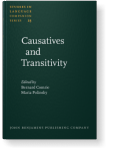Leonid Kulikov
List of John Benjamins publications for which Leonid Kulikov plays a role.
Journal
Proto-Indo-European Syntax and its Development
Edited by Leonid Kulikov and Nikolaos Lavidas
[Benjamins Current Topics, 75] 2015. v, 158 pp.
Subjects Historical linguistics | Syntax
Proto-Indo-European Syntax and its Development
Guest-edited by Leonid Kulikov and Nikolaos Lavidas
Special issue of Journal of Historical Linguistics 3:1 (2013) v, 152 pp.
Subjects Historical linguistics
The Diachronic Typology of Non-Canonical Subjects
Edited by Ilja A. Seržant and Leonid Kulikov
[Studies in Language Companion Series, 140] 2013. xxv, 364 pp.
Subjects Historical linguistics | Syntax | Theoretical linguistics | Typology
Case, Valency and Transitivity
Edited by Leonid Kulikov, Andrej L. Malchukov and Peter de Swart
[Studies in Language Companion Series, 77] 2006. xx, 503 pp.
Subjects Morphology | Semantics | Syntax | Theoretical linguistics
Tense-Aspect, Transitivity and Causativity: Essays in honour of Vladimir Nedjalkov
Edited by Werner Abraham and Leonid Kulikov
[Studies in Language Companion Series, 50] 1999. xxxiv, 359 pp.
Subjects Semantics | Theoretical linguistics | Typology
2021 Typology and diachrony of converbs in Indo-Aryan Diachronic Dimensions of Alignment Typology, Dahl, Eystein (ed.), pp. 457–501 | Article
Non-finite forms constitute an important component of the verbal system of Indo-Aryan (IA) languages. On the one hand, some of them, such as e.g., converbs, have already received proper attention in historical linguistics and typological literature, with regard to Old Indo-Aryan (OIA), Middle… read more
2019 Argument structure, conceptual metaphor and semantic change: How to succeed in Indo-European without really trying Diachronica 36:4, pp. 463–508 | Article
In contrast to grammaticalization studies of lexical verbs changing into auxiliaries, the realm of semantic changes associated with lexical verbs is an understudied area of historical semantics. We concentrate on the emergence of verbs of success from more semantically concrete verbs, uncovering… read more
2018 200 Jahre Indogermanistik . By Thomas Lindner Historiographia Linguistica 45:3, pp. 397–402 | Review
2017 Between Passive and Middle: Evidence from Greek and beyond Contrastive Studies in Verbal Valency, Hellan, Lars, Andrej L. Malchukov and Michela Cennamo (eds.), pp. 297–325 | Chapter
This paper focuses on verbs that can appear with two non-active voice morphologies in Greek. The starting point of the study is a comparison to the Vedic verbs that can also have two different, though formally related, non-active morphologies. In Vedic, these belong to the semantic… read more
2015 Chapter 1. Foreword: Rethinking perspectives in typology Valence Changes in Zapotec: Synchrony, diachrony, typology, Operstein, Natalie and Aaron Huey Sonnenschein (eds.), pp. 1–6 | Article
2015 Reconstructing passive and voice in Proto-Indo-European Proto-Indo-European Syntax and its Development, Kulikov, Leonid and Nikolaos Lavidas (eds.), pp. 101–124 | Article
This article examines various aspects of the reconstruction of the passive in Proto-Indo-European (PIE), foremost on the basis of evidence from the Indo-Aryan (Early Vedic) and Greek branches. In Proto-Indo-European the fundamental distinction within the verbal system is between the active and… read more
2013 Case variation and case alternation in Indo-European and beyond: A diachronic typological perspective Argument Structure in Flux: The Naples-Capri Papers, Gelderen, Elly van, Jóhanna Barðdal and Michela Cennamo (eds.), pp. 53–86 | Article
This paper deals with one of the aspects of the diachronic study of case, variation and competition of two or more cases in some particular function(s). The paper studies both formal parameters (markedness of case forms, interaction between declensional types) and functional features (overlapping… read more
2013 Reconstructing passive and voice in Proto-Indo-European Proto-Indo-European Syntax and its Development, Kulikov, Leonid and Nikolaos Lavidas (eds.), pp. 98–121 | Article
This article examines various aspects of the reconstruction of the passive in Proto-Indo-European (PIE), foremost on the basis of evidence from the Indo-Aryan (Early Vedic) and Greek branches. In Proto-Indo-European the fundamental distinction within the verbal system is between the active and… read more
2013 Introduction The Diachronic Typology of Non-Canonical Subjects, Seržant, Ilja A. and Leonid Kulikov (eds.), pp. ix–xxvi | Article
2012 Vedic preverbs as markers of valency-changing derivations: Transitivity and objecthood in Indo-European (Evidence from Old Indo-Aryan) Studies in Language 36:4, pp. 721–746 | Article
The present paper offers an analysis of the transitivizing and intransitivizing preverbs (semi-bound verbal prefixes) in Vedic Sanskrit. I will argue that the (in)transitivizing force of these morphemes is weak: the passivization test shows that transitivizing preverbs only exceptionally make… read more
2011 Passive to anticausative through impersonalization: The case of Vedic and Indo-European Impersonal Constructions: A cross-linguistic perspective, Malchukov, Andrej L. and Anna Siewierska (eds.), pp. 229–254 | Article
Vedic Sanskrit and other Indo-European languages attest a typologically remarkable change of passives to anticausatives. This semantic development is attested, foremost, for passives of several verbs of perception and knowledge (knowledge transfer) obviously, according to the scenario ‘Y is seen… read more
2007 16. Reciprocals in Vedic Reciprocal Constructions, Nedjalkov, Vladimir P. (ed.), pp. 709–738 | Chapter
2006 Passive and middle in Indo-European: Reconstructing the early Vedic passive paradigm Passivization and Typology: Form and function, Abraham, Werner and Larisa Leisiö (eds.), pp. 62–81 | Article
The present paper deals with the passive function of the middle diathesis in Vedic Sanskrit, one of the most ancient attested Indo-European languages. It gives a general survey of passive formations of the three main tense systems (present, aorist and perfect) and discusses forms which are… read more
2006 Case systems in a diachronic perspective: A typological sketch Case, Valency and Transitivity, Kulikov, Leonid, Andrej L. Malchukov and Peter de Swart (eds.), pp. 23–47 | Article
2000 Vedic Causative Nasal Presents and their Thematicization: A functional approach Historical Linguistics 1995: Volume 1: General issues and non-Germanic Languages., Smith, John Charles and Delia Bentley (eds.), pp. 191–210 | Article
1999 Split causativity: remarks on correlations between transitivity, aspect, and tense Tense-Aspect, Transitivity and Causativity: Essays in honour of Vladimir Nedjalkov, Abraham, Werner and Leonid Kulikov (eds.), pp. 21–42 | Article
1993 The “second causative”: a typological sketch Causatives and Transitivity, Comrie, Bernard and Maria Polinsky (eds.), pp. 121–154 | Article
1993 Through the looking-glass, and how causatives look there Causatives and Transitivity, Comrie, Bernard and Maria Polinsky (eds.), pp. 327–342 | Article
